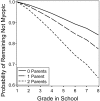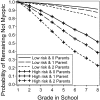Early childhood refractive error and parental history of myopia as predictors of myopia
- PMID: 19737876
- PMCID: PMC2869059
- DOI: 10.1167/iovs.08-3210
Early childhood refractive error and parental history of myopia as predictors of myopia
Abstract
Purpose: To determine the utility of a child's first grade refractive error and parental history of myopia as predictors of myopia onset between the second and eighth grades.
Methods: Subjects were nonmyopic children in the first grade who were enrolled in the Collaborative Longitudinal Evaluation of Ethnicity and Refractive Error (CLEERE) Study. Myopia was defined as -0.75 D or more myopia in both meridians (by cycloplegic autorefraction). The children were classified as having a high (versus low) risk of myopia with a cycloplegic sphere cutoff of +0.75 D or less (versus more) of hyperopia. Parental myopia was determined by a parent-completed survey. Discrete-time survival models predicted the risk of myopia.
Results: Of the 1854 nonmyopic first graders, 21.3% were at high risk of myopia. More high-risk subjects had two myopic parents, 25.4% compared with 16.5% in the low-risk group (P < 0.0001). The low-risk survival function was similar regardless of the number of myopic parents. Among high-risk eighth graders, the survival probability was lower than in the low-risk group, decreasing with an increase in the number of myopic parents. The sensitivity and specificity of first grade refractive error with the number of myopic parents as predictors for myopia onset were 62.5% and 81.9%, respectively.
Conclusions: First grade refractive error and the number of myopic parents can predict a child's risk of myopia; however, because the sensitivity of these factors is low, these two predictors may not be sufficient at this young age when a more accurate prediction of myopia onset is needed.
Figures
References
-
- Zadnik K, Satariano WA, Mutti DO, Sholtz RI, Adams AJ. The effect of parental history of myopia on children's eye size. JAMA 1994; 271: 1323–1327 - PubMed
-
- Saw SM, Shankar A, Tan SB, et al. A cohort study of incident myopia in Singaporean children. Invest Ophthalmol Vis Sci 2006; 47: 1839–1844 - PubMed
-
- Mutti DO, Mitchell GL, Moeschberger ML, Jones LA, Zadnik K. Parental myopia, near work, school achievement, and children's refractive error. Invest Ophthalmol Vis Sci 2002; 43: 3633–3640 - PubMed
-
- Pacella R, McLellan J, Grice K, Del Bono EA, Wiggs JL, Gwiazda JE. Role of genetic factors in the etiology of juvenile-onset myopia based on a longitudinal study of refractive error. Optom Vis Sci 1999; 76: 381–386 - PubMed
Publication types
MeSH terms
Grants and funding
LinkOut - more resources
Full Text Sources
Medical



